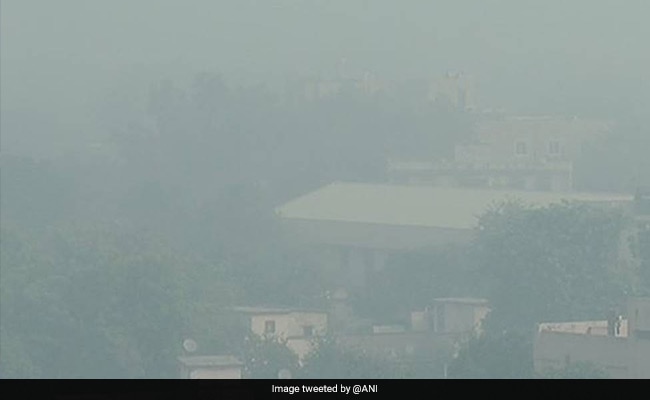
The situation was similar, if not worse, in Gurgaon, Noida and Ghaziabad.
- Day after Diwali, Delhi air "very poor" but better than last year
- Ban on sale of firecrackers in Delhi didn't ensure pollution-free Diwali
- Relatively cleaner post-Diwali air expected due to favourable conditions
Did our AI summary help?
Let us know.
New Delhi:
The morning after Diwali, as Delhi woke up to a blanket of smog indicating a spike in air pollution levels, reports suggest it's bad but better than last year. According to data from the Central Pollution Control Board (CPCB) the Air Quality Index (AQI) value on Diwali was 319, but on Friday morning it hovered between 342 and 355, placing it in "very poor" category. The AQI value on a day after Diwali (October 30) last year had rocketed from safety levels of 150 to a "severe" 999.
A ban on sale of firecrackers in Delhi this year didn't ensure a pollution-free Diwali many residents had dreamed of and the pollution level in several regions of the national capital shot above normal. The AQI value hit the dangerous 978 mark in RK Puram.
AQI level from 0-50 is considered good, 51-100 is satisfactory, 101-200 is moderate, 201-300 is poor, 301-400 is very poor, and 401 and above is severe.
 The Delhi Pollution Control Committee's (DPCC) RK Puram monitoring station recorded PM2.5 and PM10 at 878 and 1,179 micrograms per cubic metre at around 11 pm.
The Delhi Pollution Control Committee's (DPCC) RK Puram monitoring station recorded PM2.5 and PM10 at 878 and 1,179 micrograms per cubic metre at around 11 pm.
According to the System of Air Quality and Weather Forecasting and Research (SAFAR), the 24-hour rolling average of PM 2.5 and PM 10 were 154 and 256 micrograms per cubic metre respectively at around 11 pm.
The permissible level of PM 2.5 is 60µg/m³ while PM10 is 100 µg/m³.
The situation was similar, if not worse, in the neighbouring regions of Delhi such as Gurgaon, Noida and Ghaziabad.
A 'very poor' air quality index (AQI) means that people may suffer from respiratory illnesses on a prolonged exposure to such air. If the air quality dips further, the AQI will turn 'severe', affecting even those with no ailments causing harm to the respiratory system.
This time, however, a relatively cleaner post-Diwali air is expected due to favourable climatic conditions, which are helping prevent the smoke-filled air from the agricultural belt of Haryana and Punjab from entering the capital.
In 2016, the alarming smog after Diwali in Delhi-NCR had forced schools to remain closed for three days, and the National Green Tribunal had declared an environmental emergency in Delhi.
The Supreme Court-appointed body, the Environment Pollution Prevention and Control Authority, on Tuesday banned diesel generators in Delhi after the air quality entered the "Red Zone".
A ban on sale of firecrackers in Delhi this year didn't ensure a pollution-free Diwali many residents had dreamed of and the pollution level in several regions of the national capital shot above normal. The AQI value hit the dangerous 978 mark in RK Puram.
AQI level from 0-50 is considered good, 51-100 is satisfactory, 101-200 is moderate, 201-300 is poor, 301-400 is very poor, and 401 and above is severe.

The AQI value hit the dangerous 978 mark in RK Puram.
According to the System of Air Quality and Weather Forecasting and Research (SAFAR), the 24-hour rolling average of PM 2.5 and PM 10 were 154 and 256 micrograms per cubic metre respectively at around 11 pm.
The permissible level of PM 2.5 is 60µg/m³ while PM10 is 100 µg/m³.
The situation was similar, if not worse, in the neighbouring regions of Delhi such as Gurgaon, Noida and Ghaziabad.
A 'very poor' air quality index (AQI) means that people may suffer from respiratory illnesses on a prolonged exposure to such air. If the air quality dips further, the AQI will turn 'severe', affecting even those with no ailments causing harm to the respiratory system.
This time, however, a relatively cleaner post-Diwali air is expected due to favourable climatic conditions, which are helping prevent the smoke-filled air from the agricultural belt of Haryana and Punjab from entering the capital.
In 2016, the alarming smog after Diwali in Delhi-NCR had forced schools to remain closed for three days, and the National Green Tribunal had declared an environmental emergency in Delhi.
The Supreme Court-appointed body, the Environment Pollution Prevention and Control Authority, on Tuesday banned diesel generators in Delhi after the air quality entered the "Red Zone".
Track Latest News Live on NDTV.com and get news updates from India and around the world

